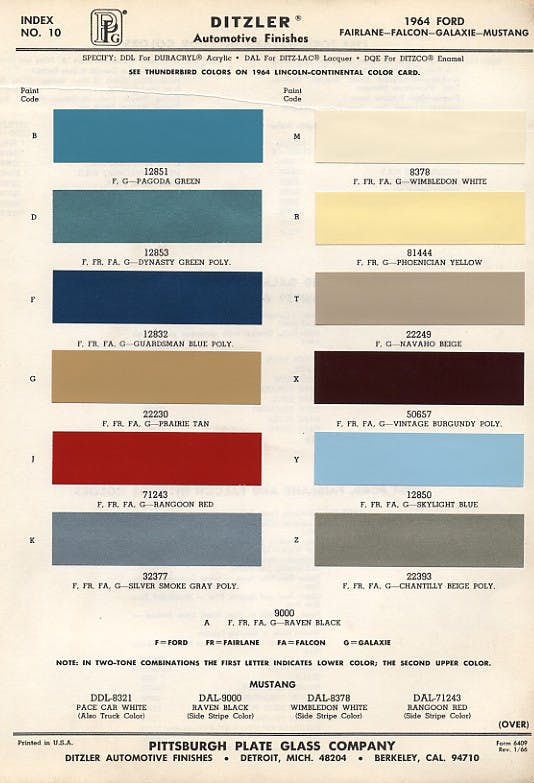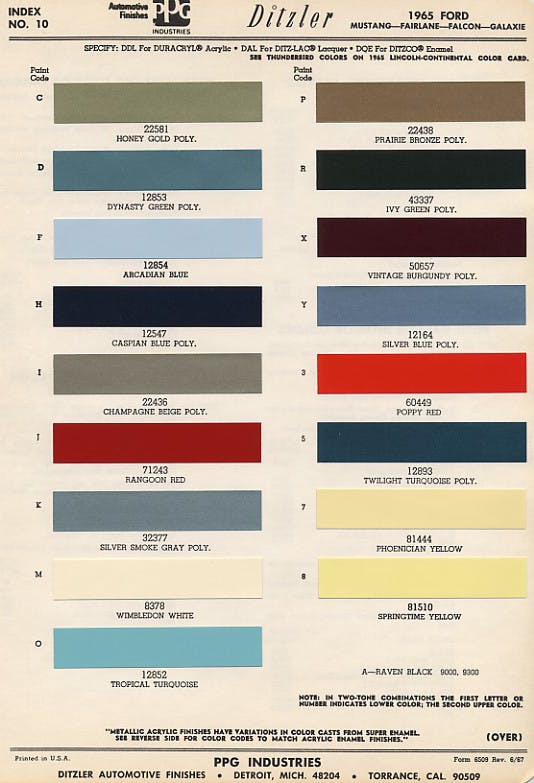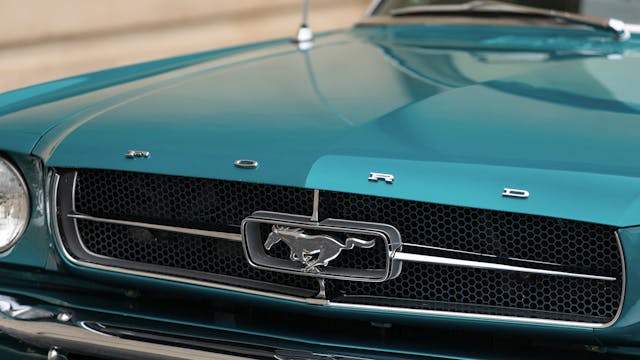Which Original Mustang Paint Color Is Worth the Most?
April 17 marks sixty years since the Ford Mustang’s public debut at the 1964 New York World’s Fair. The original pony car immediately became a pop-culture and automotive phenom, and it remains one of the most impactful cars in history. We’re celebrating with stories of the events surrounding the Mustang’s launch, the history of the early cars, and tales from owners. Click here to follow along with our multi-week 60 Years of Mustang coverage. —Ed.
When the Ford Mustang debuted sixty years ago at the World’s Fair in New York on April 17, 1964, it became an overnight hit. However, though Ford accurately targeted the up-and-coming baby boomer generation with the car’s avant-garde design and features, the Mustang wore many colors that were more ’50s pastels than ’60s shock. The discrepancy between the car’s image and its colors has complicated the picture for Mustang enthusiasts ever since. Many owners have opted to repaint their Mustangs, while others have sought cars painted in a rare, original shade. Which original colors are most likely to be covered with a repaint, and which original colors are most valuable? Read on.
For the 1965 model year, the Mustang was available in 24 colors (a few, like Pagoda Green, were only available on the 1964 ½ cars). Yellows, golds, blues, turquoises, beiges, reds, and greens were available, along with more common colors like black, white, and silver.


Some of the original colors aren’t especially valued by enthusiasts today—specifically, Silver Smoke Gray and Silver Blue. To reach that conclusion, we reviewed auction data from over 700 sales, going back to 2014, and compared those results to condition-appropriate values from the Hagerty Price Guide, whether the car in question was a six-cylinder or a K-code, a notchback or a convertible. We found that Silver Blue is worth just 5 percent more on average, and Silver Smoke Gray just 8 percent more.

Rarely seen or ordered, Prairie Bronze is worth nearly one-third less on average, and so is Sunlight Yellow. Vintage Burgundy is popular (almost 50 out of the 700 cars in our data set wore it) but typically worth 16 percent less on average. Conversely, Wimbledon White is relatively common (almost 40 transactions) but worth 16 percent more. Twilight Turquoise isn’t as common (about 20 sales), but worth 19 percent more. Dynasty Green is rare, with just three sales in the past ten years, and worth 24 percent more. A car wearing its original Raven Black is also worth a lot, despite being somewhat common (15 sales): This color is worth nearly 30 percent more on average. The prize for the most valuable color goes to the rarely seen, 1964 ½-only Pagoda Green, worn by only one car out of the 700: This color is worth 61 percent more.
If we group together all the colors, whether original or not, we see that yellows are worth the least on average, followed by reds and blacks, which are very common. However, white is more valuable on average, even though it’s frequently used, and so are orange, turquoise, and green. Gold, blue, green, and silver are in the middle.

What original Mustang colors are most likely to be painted over? Surprisingly, Wimbledon White: Though it is worth 16 percent more than other original colors, on average, it is replaced by a different one almost 75 percent of the time in our data set. Silver Blue, Silver Smoke Gray, Honey Gold, and Prairie Bronze are painted over nearly as often. Given the popularity of red in our dataset (150+ transactions), Poppy Red and Rangoon Red are rarely swapped out. Valuable Raven Black is also rarely painted over, as are Ivy Green and Twilight Turquoise.

What colors do owners typically use for a repaint? Red is the most popular shade, picked almost one-third of the time. It is followed by blue, white, black, and silver. Though Wimbledon White is often painted over, it is also occasionally picked as a repaint shade.

Which 1965-model-year Mustang color is most valuable to you?
***
Check out the Hagerty Media homepage so you don’t miss a single story, or better yet, bookmark it. To get our best stories delivered right to your inbox, subscribe to our newsletters.



production numbers for each color would really put the article in perspective my 65 fastback is silver smoke gray and you don,t see many at car shows, auction results is for car flippers
Always liked the yellows. Thought they looked clean and simple, though I did paint my 67 fastback inferno red
Continue with ranking all the first generation colors like this. I’m curious where my medium aqua 73 Mach 1 color ranks !
Grabber Blue….as applied to my Smyth Charger Ute.
my 1969 mach 1, candy apple red
Uh, off point, but wasn’t Warren Tope’s 1970 Boss 302 TA race car in red, white and blue just about the prettiest race car livery in the 70 TA?
Does anyone have any idea what the most popular colors were on the early Mustangs AT THAT TIME?
Nightmist & Brittany Blues have historically done well
Man, have we gone downhill since the government took over! Only colors on the road today are black, white and gray, which is a combination of black and white.
Thats the big color wheel at every Tesla dealer.
The most valuable color is the one you like. Period. You’re the one who has to live with it. I hear the same when cooking foods. “This is the right way”. No, the right way is the way you like it cooked. Period. Personally, I get tired of seeing “resale red” I’ve owned over 30 cars from all marques, and all colors including red, black, and white. I really don’t care for all 3 of them. Just so happened that was the color on the car when I bought it, which was for other features of the car.
I remember sitting a Mustang coupe at the 1964 NY World’s Fair. It was Vintage Burgundy with a gold interior. 289 4-speed. I was 11 at the time, and still remember it like it was yesterday. If I was 20 or so and had the money, I’d have bought that car. I never in all these years forgot that car. been a Mustang lover ever since.
Acapulco Blue on my 67
Ivy Green was definitely GREEN, but I think the rest of the greens were blue/green in different variation. The turquoise cars were always my favorite.
My ‘67 Fastback is original Candy Apple Red with red standard interior. It’s a perfect combination.
My ’66 convertible came from the factory springtime yellow. I repainted it raven black.